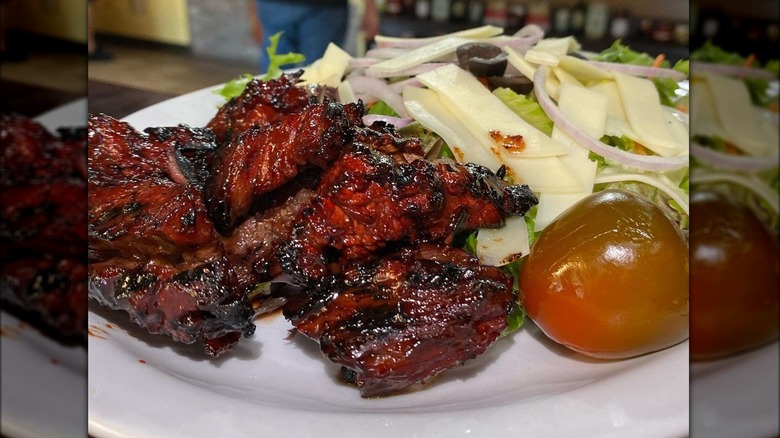What's The Difference Between East Coast And West Coast Steak Tips?
We may receive a commission on purchases made from links.
Whether you call 'em pancakes, flapjacks, or hot cakes, a griddled beauty by any name still tastes as sweet (and the same). But, in the case of East Coast versus West Coast steak tips, the difference is more than just a matter of regional vernacular. The East Coast is home to New England steak tips, and the West Coast is home to the tri-tip steak. Steak tips come from the bottom sirloin cut (aka the flap steak or bavette). This bottom sirloin can be sold as one large slab of meat, or cut into roughly-hewn two-inch long pieces known as (you guessed it) steak tips. But across New England, the term "steak tips" can also refer to flank or tenderloin tips that are marinated and grilled.
Tri-tip steak, on the other hand, comes from a more specific part of the steer: the subprimal between the top sirloin and bottom round at the hind quarter. This area is roughly triangular-shaped, hence the "tri-tip" name. Beyond their shapes and specific cuts, the biggest difference that separates these steaks is their preparation methods. East Coast steak tips can be a tough cut to handle, which is where that tenderizing steak marinade comes in. They're also pre-sliced into small chunks before cooking. West Coast tri-tip, by comparison, is rippled with considerable fat and almost never marinated. Instead, it's hit with a simple seasoning before grilling or roasting, then sliced post-cook.
East Coast steak tips are a regional New England staple
Per the lore, thrifty New England butchers are credited with inventing this now-classic regional dish by marketing marinated sirloin tips as an appealing way to sell off less-desirable cuts of beef. Even though steak tips don't have one designated inventor, the meat's popularity boomed across the region during the 1960s and '70s. If anything, that popularity has grown in the years since, as steak tips can be found in pretty much any grocery store in New England, often pre-soaked in marinade. Steak tips are especially popular in Boston, New Hampshire, Vermont, and Maine. The cut's naturally loose grain makes it ideal for absorbing flavorful marinades — which is good, because this tough cut needs a little help on the tenderization front.
Common tenderizing marinades include Italian salad dressing, balsamic vinegar, maple syrup, ketchup, barbecue sauce, red wine vinegar, or even cola. Mostly any thin, bold fridge staple condiment will do the trick. The fan favorite steak tips recipe published by the authority at New England.com calls for a marinade of bourbon, brown sugar, Worcestershire sauce, and soy sauce, which soaks into the meat alongside a few thick slices of yellow onion. To cook, steak tips perform best using high heat, quick-cooking methods such as grilling, pan-searing, or broiling. It's definitely one of the New England foods you need to try at least once.
Tri-tip steak is a California jewel of the Santa Maria barbecue scene
Not unlike the purportedly thrifty origin story of New England steak tips, the West Coast popularity of the tri-tip can be traced back to Bob Schutz, a Santa Maria butcher who was (allegedly) the first to sell this cut whole to customers in the 1950s instead of tossing it to the ground beef machine. The affordable, richly marbled cut found a fast audience among foodies in Central California. Fast forward 70 years and the demand for tri-tip steak has exceeded its supply. Foodies outside of the West Coast might be hard-pressed to track down a tri-tip steak unless they're able to special request the cut from their local butcher. Although, some meat purveyors based in California ship their tri-tip nationwide, so foodies beyond the Golden State can sink their teeth in.
West Coast tri-tip steak can be sold as a full slab of boneless meat or, like New England steak tips, cut into cubes or small slices to sell. Tri-tip is also known as California cut or Santa Maria steak, a key offering of the traditional Santa Maria barbecue scene. It's naturally more tender than steak tips thanks to its fat marbling, but it can also be tough if overcooked, and must be sliced against the grain to be chewable. That marbling makes tri-tip relatively simple to work with — it's typically barbecued at high heat over a redwood grill to cook and requires minimal prep. Try it in this grilled tri-tip with blackberry mustard recipe. It's definitely one of the unique California foods you need to try.


